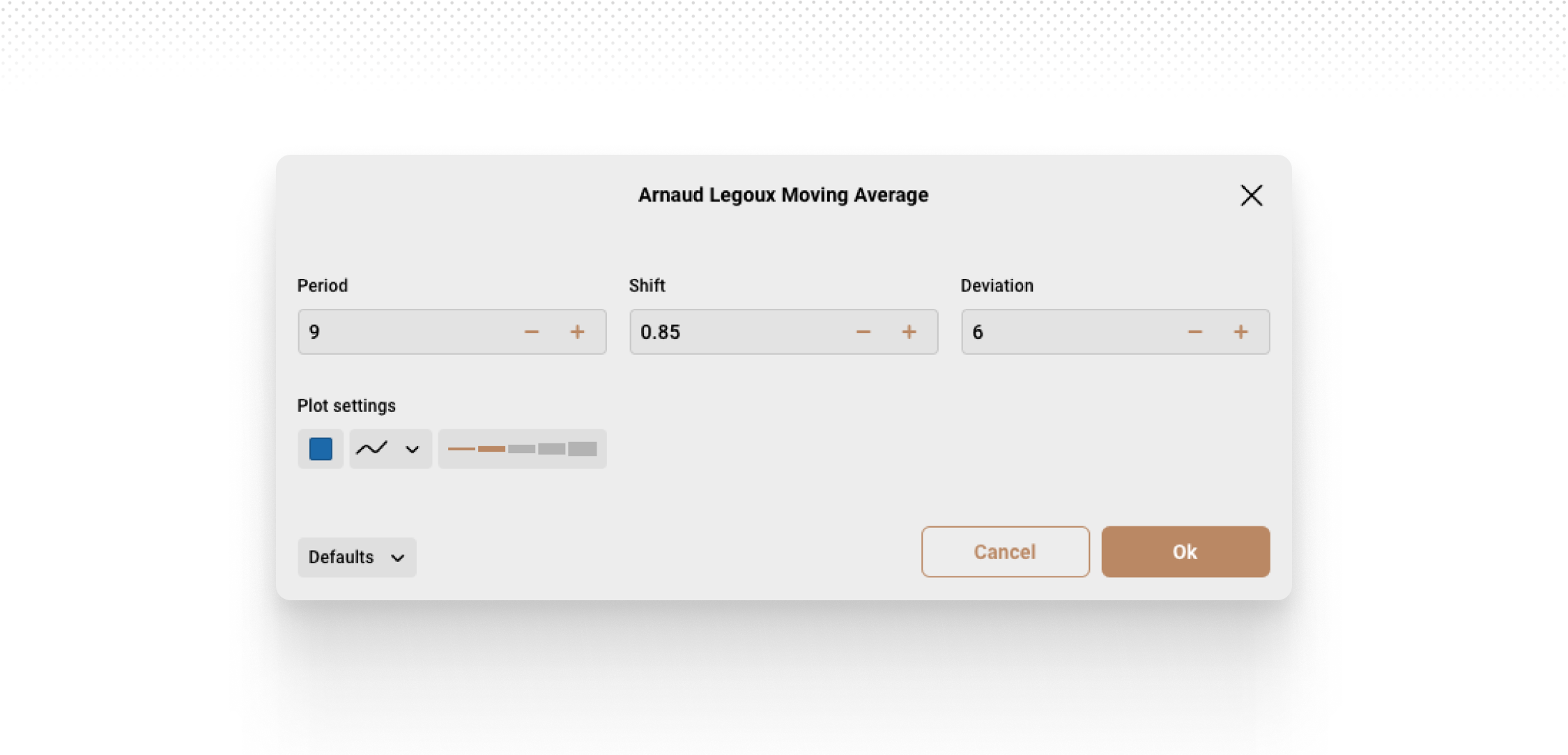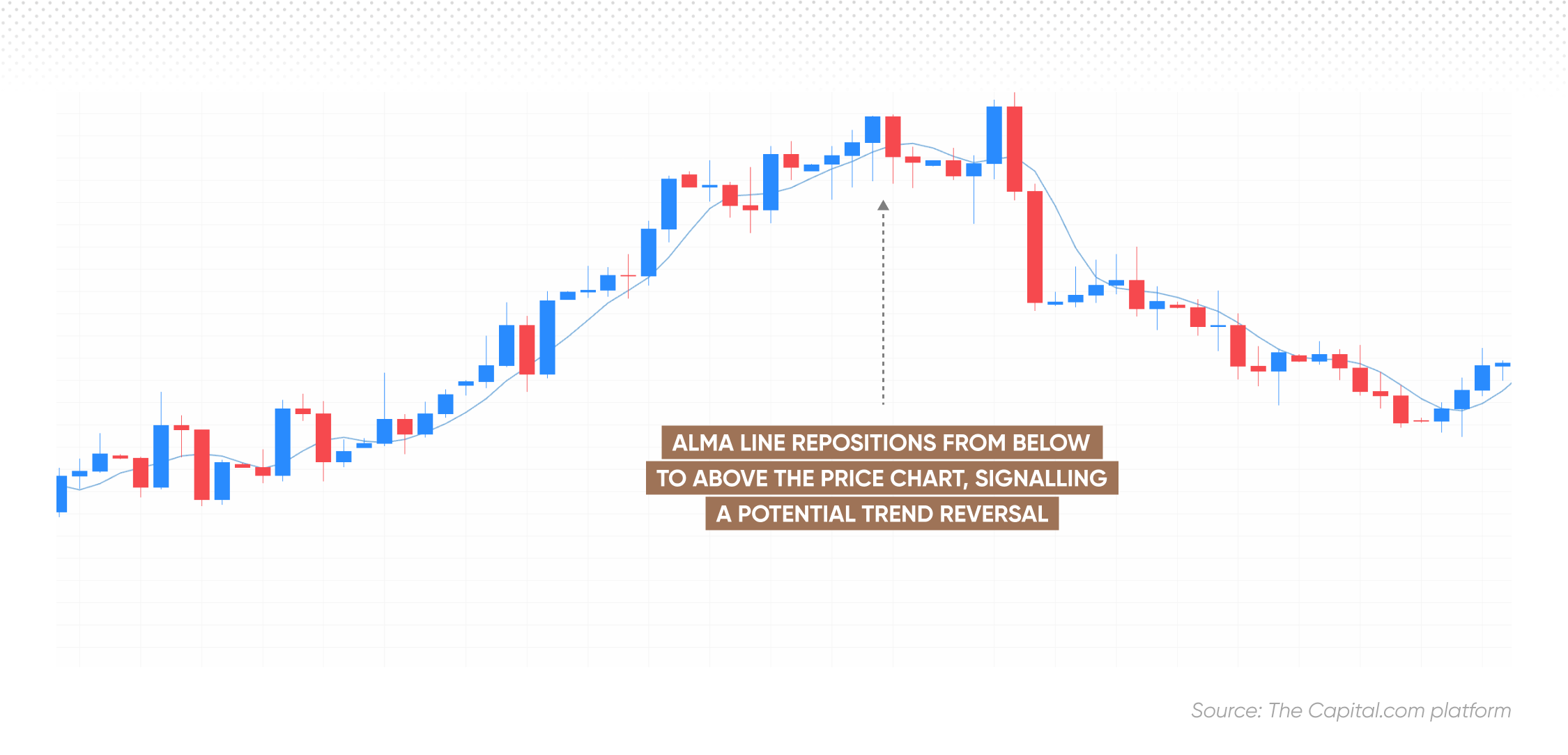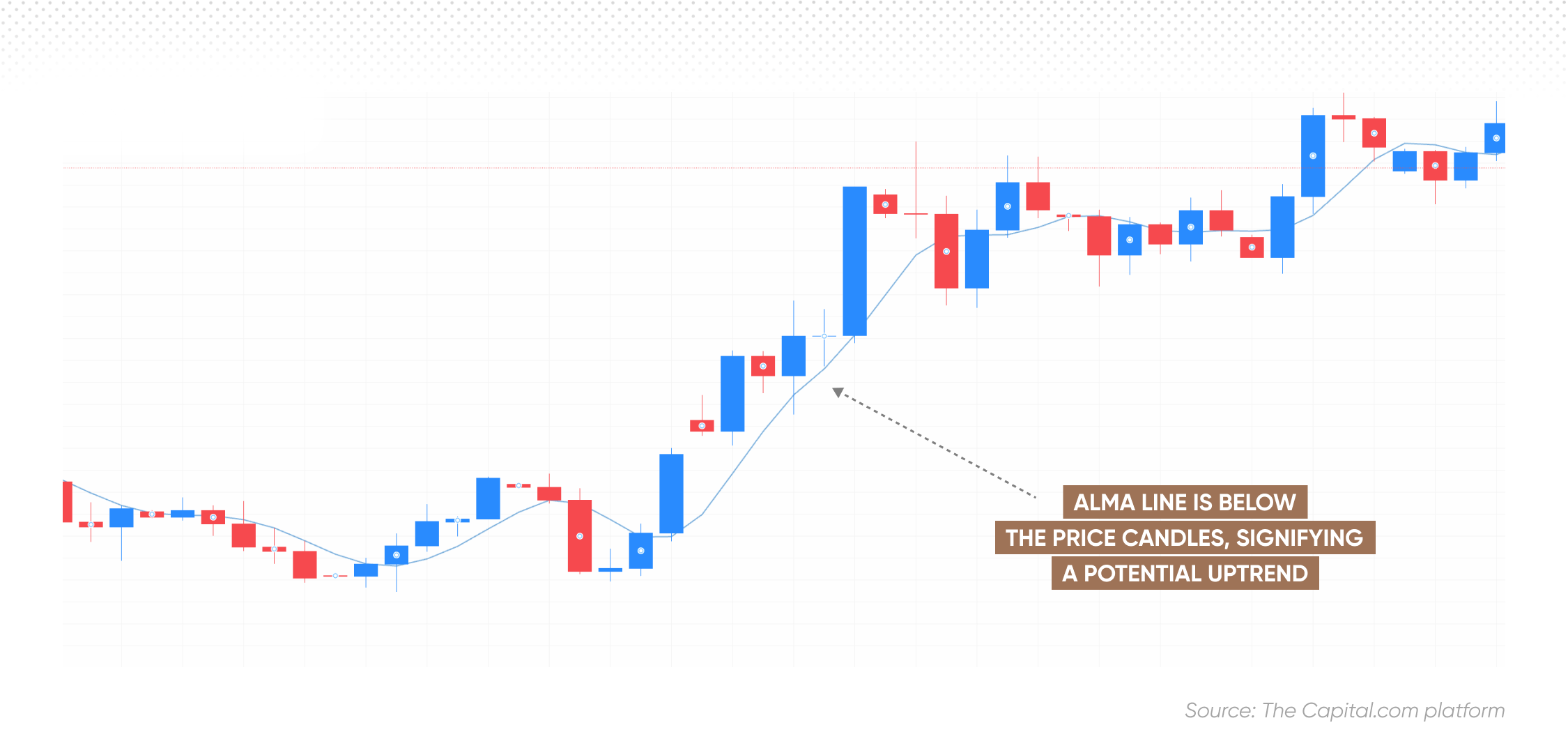Arnaud Legoux moving average

Explore the ALMA trading strategy and learn the calculation process, indicator settings, and how to use ALMA in trading. Read on for more in our guide.
What is ALMA trading strategy?
The ALMA trading strategy is a trading approach that incorporates the Arnaud Legoux moving average (ALMA), which is a technical analysis indicator that calculates the average price of an asset over a specific period using Gaussian distribution function.
Created by French mathematicians Arnaud Legoux and Dimitris Kouzis-Loukas in 2009, it aims to provide a responsive and smooth moving average (MA) while reducing lag and noise.
Highlights
- ALMA is a technical analysis indicator designed to provide a responsive and smooth moving average while reducing lag and noise.
- Created by Arnaud Legoux and Dimitris Kouzis-Loukas, it uses a Gaussian distribution function to assign weights to data points within the specified period.
- ALMA can be used for trend identification, trend reversal, dynamic support and resistance, and combined with other indicators to enhance trading strategies.
- Combining ALMA with two EMAs is a popular ALMA trading strategy, yet there are more ways of using the indicator.
- ALMA offers advantages such as smoothness, filtering capabilities, and reduced lag, but traders should be aware of risks such as false signals, complex calculations, and the importance of using it in conjunction with other indicators.
ALMA trading strategy explained
Calculating ALMA
Although the Arnaud Legoux moving average indicator is available on most charting and trading platforms, it may be helpful to understand the calculation process behind it for traders to use ALMA effectively.
The ALMA formula is based on a weighted sum using a specified time period and the Gaussian filter offset. The weights are determined by a Gaussian distribution function. The average is applied in a way that minimises the lag often associated with traditional moving averages.
In short, the default Arnaud Legoux moving average formula is:
Where:
-
Weighted sum of prices: In this part of the calculation, each price within the selected period is multiplied by a specific weight. The weight is determined using a Gaussian function, which helps to assign higher weights to more recent prices and lower weights to older prices. This allows the ALMA to focus more on recent price data, making it more responsive to price changes.
-
Sum of weight: This component is simply the sum of all the weights that were assigned to the prices in the selected period. By summing these weights, you can normalise the ALMA, ensuring that the final result is not skewed by the weighting process. To calculate the sum of weight, you would add up all the weights that were determined using the Gaussian function for each price within the selected period.
Indicator settings
When setting up ALMA parameters, it's crucial to consider your trading strategy and time horizon. There are three key components of the ALMA indicator: window size, offset and sigma. They can be named differently on various platforms. For example, on Capital.com they are called period, shift and deviation.
It's important to note that the standard deviation is not directly involved in the Arnaud Legoux moving average calculation; however one of the indicator’s parameters, sigma, refers to the deviation used as part of the Gaussian distribution function.

-
Period or window size: The window size, also known as the length or lookback period, determines how many historical data points are used in the ALMA calculation. A shorter window size will make the ALMA line more responsive to recent price changes but may also increase the noise and the likelihood of false signals. A longer window size will make the ALMA line smoother, with less noise, but may cause more lag in reacting to price changes.
-
Shift or offset: The offset determines the position of the Gaussian filter, which is used to weight the data points in the moving average calculation. The offset is expressed as a fraction of the window size, with a value between 0 and 1. A higher offset will shift the Gaussian filter closer to the more recent data points, making the ALMA more responsive to recent price changes but potentially increasing noise. A lower offset will shift the Gaussian filter closer to the centre of the window, resulting in a smoother ALMA line but potentially introducing more lag.
-
Deviation or sigma: In the context of ALMA, sigma refers to the standard deviation used in the Gaussian distribution function. This parameter determines the smoothness of the curve and the degree to which data points close to the centre of the window are weighted more heavily than those further away. A smaller sigma will result in a narrower Gaussian filter, leading to a more responsive ALMA but with a higher chance of noise and false signals. A larger sigma will result in a wider Gaussian filter, creating a smoother ALMA line but with more lag.
Traders can experiment with various window sizes to find the optimal balance between responsiveness and noise reduction. They can also test their settings on a demo account to examine the signals and align with their specific objectives. Remember to always conduct your own due diligence before trading, and never trade more money than you can afford to lose.
ALMA trading strategies
There are several ways to use the ALMA indicator in trading. For example, for trend analysis or pairing it with other technical tools for a fuller picture.
How to use ALMA indicator in trading
There are several different ways you can use the indicator, and you can pair it with other technical analysis tools for a fuller picture.
Trend identification
The Arnaud Legoux moving average can help identify the price trend direction, revealing if it's bullish (upward) or bearish (downward).
When the lowest point of each candlestick on a price chart is below the ALMA line, it suggests a potential bearish trend. Conversely, if the lowest point is above the ALMA line, it indicates a possible bullish trend.
Meanwhile, the wider the distance between the candlesticks and the ALMA line, the stronger the trend. A narrowing gap between them could signal a potential trend reversal.
Past performance is not a reliable indicator of future results.
Trend reversal
As noted earlier, when the Arnaud Legoux moving average line begins to change direction in relation to the price chart, it can provide early warnings of potential trend reversals.
For instance, if the price moves from consistently being above the ALMA line (indicating a bullish trend) to crossing below it, it could signal a shift towards a bearish trend. Similarly, if the price transitions from consistently being below the ALMA line (signifying a bearish trend) to crossing above it, it may suggest a shift towards a bullish trend.
ALMA line repositions from below to above the price chart, signalling a potential trend reversal.

Past performance is not a reliable indicator of future results.
Support and resistance
The Arnaud Legoux moving average can also serve as a dynamic support and resistance as it can adapt to changing price action.
When the price is above the ALMA line, it may act as a support level, suggesting that the price could bounce off the line and move higher. Conversely, when the price is below the ALMA line, it could act as a resistance level, indicating that the price might face downward pressure and could reverse lower.
Traders who follow this strategy may consider a long position when the price approaches the ALMA line from above, treating it as a potential support level. Similarly, they could consider a short position when the price approaches the ALMA line from below, treating it as a potential resistance level.
Combine with other indicators
The Arnaud Legoux moving average can be combined with other moving averages with different calculation methods and timeframes to enhance trading strategies and potentially enhance the quality of the signals. It can also be used in conjunction with other indicators such as relative strength index (RSI), parabolic stop and reserve (SAR), and Bollinger Bands® to confirm a trend and determine its strength.
ALMA and EMAs trading strategy
The strategy combines the benefits of ALMA's smoothness and responsiveness with the more traditional EMA, enabling traders to capture the best of both worlds.
To set up this ALMA strategy, you will need to plot three moving averages on your chart: the long-period ALMA (for example for 100 days) and two short-term EMAs (for example for 10 and 15 days).
In this ALMA indicator strategy, the ALMA serves as the primary trend filter, dictating whether long or short positions are taken when the price is above or below the ALMA. The 10 and 15-day EMAs are incorporated to provide bullish or bearish crossover signals.
For example, when ALMA is below the price, combined with a 10-day EMA crossing over 15-day EMA, this can be considered a bullish signal. Conversely, when ALMA is above the price, and 15-day EMA is crossing over the 10-day EMA, this can be considered a bearish signal.
ALMA crosses below the price chart, while the 10-day EMA crosses above the 15-day EMA, indicating a potential bullish uptrend

Past performance is not a reliable indicator of future results.
Why choose ALMA?
-
Smoothness: ALMA is designed to provide a smoother moving average line that could help reduce noise and false signals, and assist in identifying actual trends.
-
Filtering capabilities: ALMA combines the benefits of weighted moving averages and Gaussian filters, offering an effective way to filter out excessive signals during indecisive markets.
-
Reduced lag: ALMA's unique calculation method results in less lag compared to traditional moving averages, which means faster reaction times for traders.
Risks associated with ALMA
-
False signals: While ALMA is designed to reduce false signals, it is not immune to them. Traders must be cautious and use additional confirmation techniques to avoid false signals.
-
Complex calculation: ALMA's calculation method is more complex than standard moving averages, which might make it difficult for some traders to understand and apply correctly.
-
Not a standalone indicator: Like any other technical indicator, ALMA should not be used as a standalone tool for making trading decisions. It should be combined with other indicators and price action analysis.
Conclusion
ALMA is a valuable technical analysis indicator that provides a smooth and responsive moving average by using a Gaussian distribution function to assign weights to data points within a specified period. It stands out from other moving average types due to its unique calculation method, which reduces lag and noise.
Traders can use ALMA for various purposes, such as trend identification, trend reversal, and dynamic support and resistance. A common ALMA trading strategy incorporates ALMA and two EMAs.
While ALMA offers advantages like smoothness, filtering capabilities, and reduced lag, it's essential for traders to be aware of potential risks such as false signals and the need to combine it with other indicators and price action analysis. For traders who have decided to use the ALMA trading strategy, understanding calculations behind the indicator is key for decision-making.
FAQs
How to use the ALMA indicator?
To use the ALMA indicator, a trader could apply it to a price chart and observe its relationship with the price to identify trends, trend reversals, and dynamic support and resistance levels.
How to read the ALMA indicator?
To read or interpret the ALMA indicator, a trader could start by looking at the position of the price in relation to the ALMA line, and the direction of the line. If the ALMA moves above the price chart, it indicates a potential bearish trend, and vice versa, when ALMA moves below the price, it can signal a possible bullish trend.
What are the best time frames to use ALMA?
The best time frames for using ALMA depend on your trading strategy and objectives; you can experiment with different timeframes to find the optimal balance between responsiveness and noise reduction.
How can I combine ALMA with other indicators?
A trader could combine ALMA with other indicators such as EMA, RSI, Parabolic SAR, or Bollinger Bands® to confirm trends, determine their strength, and reinforce the trading signals received.
